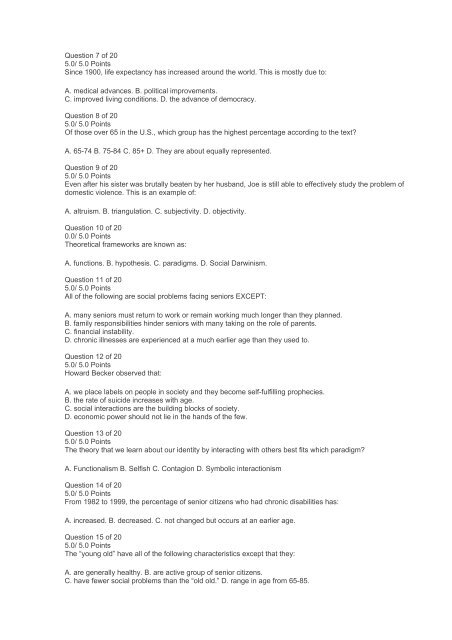S05 Social Problems Exam 1 Answers (Ashworth College)
Create successful ePaper yourself
Turn your PDF publications into a flip-book with our unique Google optimized e-Paper software.
Question 7 of 20<br />
5.0/ 5.0 Points<br />
Since 1900, life expectancy has increased around the world. This is mostly due to:<br />
A. medical advances. B. political improvements.<br />
C. improved living conditions. D. the advance of democracy.<br />
Question 8 of 20<br />
5.0/ 5.0 Points<br />
Of those over 65 in the U.S., which group has the highest percentage according to the text?<br />
A. 65-74 B. 75-84 C. 85+ D. They are about equally represented.<br />
Question 9 of 20<br />
5.0/ 5.0 Points<br />
Even after his sister was brutally beaten by her husband, Joe is still able to effectively study the problem of<br />
domestic violence. This is an example of:<br />
A. altruism. B. triangulation. C. subjectivity. D. objectivity.<br />
Question 10 of 20<br />
0.0/ 5.0 Points<br />
Theoretical frameworks are known as:<br />
A. functions. B. hypothesis. C. paradigms. D. <strong>Social</strong> Darwinism.<br />
Question 11 of 20<br />
5.0/ 5.0 Points<br />
All of the following are social problems facing seniors EXCEPT:<br />
A. many seniors must return to work or remain working much longer than they planned.<br />
B. family responsibilities hinder seniors with many taking on the role of parents.<br />
C. financial instability.<br />
D. chronic illnesses are experienced at a much earlier age than they used to.<br />
Question 12 of 20<br />
5.0/ 5.0 Points<br />
Howard Becker observed that:<br />
A. we place labels on people in society and they become self-fulfilling prophecies.<br />
B. the rate of suicide increases with age.<br />
C. social interactions are the building blocks of society.<br />
D. economic power should not lie in the hands of the few.<br />
Question 13 of 20<br />
5.0/ 5.0 Points<br />
The theory that we learn about our identity by interacting with others best fits which paradigm?<br />
A. Functionalism B. Selfish C. Contagion D. Symbolic interactionism<br />
Question 14 of 20<br />
5.0/ 5.0 Points<br />
From 1982 to 1999, the percentage of senior citizens who had chronic disabilities has:<br />
A. increased. B. decreased. C. not changed but occurs at an earlier age.<br />
Question 15 of 20<br />
5.0/ 5.0 Points<br />
The “young old” have all of the following characteristics except that they:<br />
A. are generally healthy. B. are active group of senior citizens.<br />
C. have fewer social problems than the “old old.” D. range in age from 65-85.

















